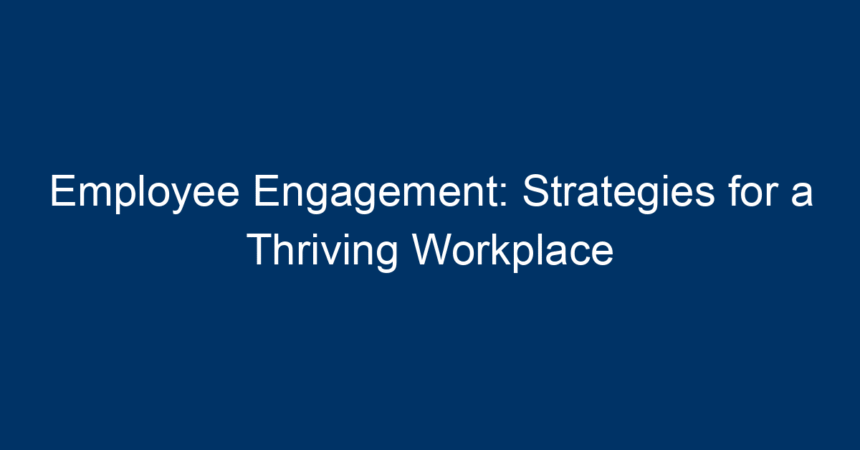Employee engagement has emerged as a pivotal focus for organizations aiming for success and sustainability. Engaged employees are not just satisfied; they are emotionally invested in their work and aligned with the company’s mission and values. A thriving workplace fosters creativity, productivity, and ultimately, profitability. In this article, we will explore effective strategies for enhancing employee engagement and creating an environment where both employees and the organization can flourish.
Understanding Employee Engagement
What is Employee Engagement?
Employee engagement is the level of commitment and involvement an employee has toward their organization and its values. Unlike simple job satisfaction, employee engagement encompasses a deeper emotional connection. Engaged employees are more likely to go the extra mile, collaborate effectively, and contribute to a positive workplace culture.
Why is Employee Engagement Important?
Investing in employee engagement leads to a host of benefits:
- Increased Productivity: Engaged employees are often more productive, fostering higher efficiency and output.
- Reduced Turnover Rates: Organizations with high engagement levels experience lower turnover, saving costs associated with hiring and training.
- Enhanced Customer Satisfaction: Satisfied employees tend to provide better customer service, resulting in higher customer retention.
To cultivate this level of engagement, organizations must implement targeted strategies.
Strategies for Enhancing Employee Engagement
1. Foster Open Communication
Communication is the bedrock of any thriving workplace. Establishing open channels where employees feel heard and valued can dramatically boost engagement.
- Regular Feedback: Implement programs for regular check-ins and constructive feedback sessions. This not only helps employees grow but also allows them to voice their concerns and suggestions.
- Encourage Transparency: Share company updates, challenges, and successes with employees. Transparency fosters trust and helps employees feel like stakeholders in the organization’s journey.
2. Recognize and Reward Contributions
Recognition is a powerful motivator in the workplace. Acknowledge the hard work and contributions of employees in meaningful ways.
- Formal Recognition Programs: Create awards or recognition programs for outstanding performance. Consider both peer nominations and manager recognition to build a culture of appreciation.
- Personalized Rewards: Understand what makes each employee feel valued. Some may appreciate public recognition, while others may prefer private acknowledgment or tangible rewards.
3. Invest in Employee Development
Offering opportunities for professional growth is crucial for retaining engaged employees.
- Training Programs: Implement regular training and development workshops tailored to different skill levels and career aspirations.
- Career Pathing: Help employees identify potential career paths within the organization and provide the necessary resources and experiences to help them grow.
4. Promote Work-Life Balance
A healthy work-life balance is fundamental to employee well-being and engagement.
- Flexible Work Arrangements: Consider offering remote work options, flexible hours, or compressed workweeks to accommodate diverse employee needs.
- Encourage Time Off: Foster a culture that values taking breaks and vacations. Encourage employees to step away from work without guilt to recharge and avoid burnout.
5. Create a Collaborative Work Environment
Cultivating a collaborative culture enhances employee engagement by fostering teamwork and mutual support.
- Team-Building Activities: Organize regular team outings, workshops, or brainstorming sessions to strengthen relationships and encourage collaboration.
- Cross-Department Projects: Facilitate joint projects between different departments to expose employees to new ideas and diverse perspectives.
6. Focus on Employee Wellness
Employee engagement is closely tied to overall well-being. Supporting employees’ mental and physical health can enhance their engagement levels.
- Wellness Programs: Implement health initiatives such as fitness challenges, mindfulness sessions, or access to wellness resources. These programs demonstrate that you value employees’ overall health.
- Support Mental Health: Provide access to counseling services, mental health days, or stress management resources to show employees that their emotional well-being is important.
7. Gather and Act on Employee Feedback
Feedback is an invaluable tool for understanding employee sentiment and enhancing engagement.
- Surveys and Polls: Conduct regular employee engagement surveys to gauge satisfaction levels and identify areas for improvement.
- Responsive Action: Once you gather feedback, it’s crucial to take action. Communicate how you plan to address their concerns to build trust and show commitment.
Cultivating a Positive Workplace Culture
Defining Your Culture
A positive workplace culture is vital for employee engagement. It determines the overall environment and shapes employee experience.
- Establish Core Values: Clearly define your organization’s core values and ensure they align with employee engagement efforts. These values should resonate with employees and guide behaviors within the workplace.
- Celebrate Diversity and Inclusion: Create an inclusive environment where diverse perspectives are valued. Promote initiatives and support systems that celebrate different backgrounds, experiences, and ideas.
Leadership Development
Strong leadership is key to maintaining high levels of employee engagement.
- Leadership Training: Invest in leadership programs that foster skills such as emotional intelligence, communication, and conflict resolution. Effective leaders can inspire and motivate employees, driving engagement.
- Lead by Example: Leaders should model the behavior they wish to see in their teams. When leadership is engaged and committed, it sets the tone for the rest of the organization.
Measuring Employee Engagement
Key Metrics
To understand the effectiveness of your engagement strategies, measuring outcomes is essential.
- Engagement Surveys: Conduct regular surveys to assess employee engagement levels and identify trends. Analyze results for actionable insights.
- Retention Rates: Monitor turnover rates as a key indicator of employee engagement. A decrease in turnover often signifies improved engagement.
Continuous Improvement
Engagement is not a one-time effort but a continual process. Regularly review and refine your strategies based on employee feedback and the evolving workplace landscape.
Conclusion: Actionable Insights for a Thriving Workplace
Enhancing employee engagement is a multifaceted endeavor that requires commitment, creativity, and continual adaptation.
- Foster open communication and transparency.
- Implement recognition programs that resonate with employees.
- Invest in training and development.
- Promote work-life balance and employee wellness.
- Create a collaborative environment that values teamwork.
- Act on feedback to demonstrate responsiveness.
By implementing these strategies, organizations can create a thriving workplace where engaged employees feel valued, connected, and motivated. Investing in employee engagement is not just a goodwill effort; it’s a strategic approach that leads to enhanced productivity, reduced turnover, and ultimately, a more robust bottom line. Embrace these strategies today and watch your workplace transformation unfold.




